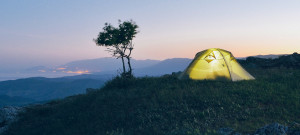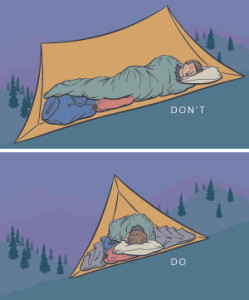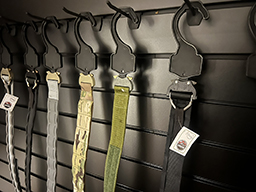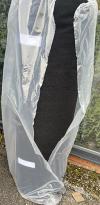Comfortable Sleeping Under The Stars

Kids love sleeping out in the great outdoors may it be in a tent or under the stars. But for some adults, “sleeping out” doesn’t offer much in the way of an enjoyment.
No matter how hard you might try, sometimes finding a level spot to pitch your tent is impossible. The ground can offer many surprises such as slopes, bunches of lumps or worse, heavy rain can cause a middle-of-the-night washout.
If you want to get a good night’s rest, the key to comfort is how you pitch a tent and prepare your bed.
Pitching on a slope
 Wisdom advises that you pitch your tent with the head end uphill, and then use clothes and other parts of kit under your lower body for support and to level the pitching site. But this can create a hammock like sleeping effect that may produce a morning backache.
Wisdom advises that you pitch your tent with the head end uphill, and then use clothes and other parts of kit under your lower body for support and to level the pitching site. But this can create a hammock like sleeping effect that may produce a morning backache.
However this can be avoided by pitching the tent perpendicular to the drop (one side lower than the other). Then, level your sleeping pad by placing clothes under the downhill side so you will roll into the tent wall, rather than fall out the door. You’re creating a “level trough” that’s much more comfortable to sleep in than a “hammock.”
If you’ve pitched your tent in a low spot and it rains hard enough, groundwater will flow into your tent. Many years ago this water flow was controlled by digging a trench around the tent — a procedure that causes soil erosion and, consequently, has become prohibited on most areas of land. Instead, of tampering with the land around you, you can place an over-sized plastic ground sheet inside your tent. Make the ground sheet large enough to rise about a foot up the sidewalls of your tent.
Any groundwater that gets into your tent will be trapped beneath the plastic sheet, and you’ll stay dry.
Sleeping Ideas
On summer nights, a sleeping bag can get too hot and laying directly on your air mattress or foam pad seems like a cunning plan— except the plastic/nylon covering on these pads becomes too hot and sticky. The solution: Make a fitted-cotton flannel cover for your pad. The cotton wicks away sweat, can guard against risk of punctures, and prevents the pad from sliding around on the slick plastic groundsheet below.













